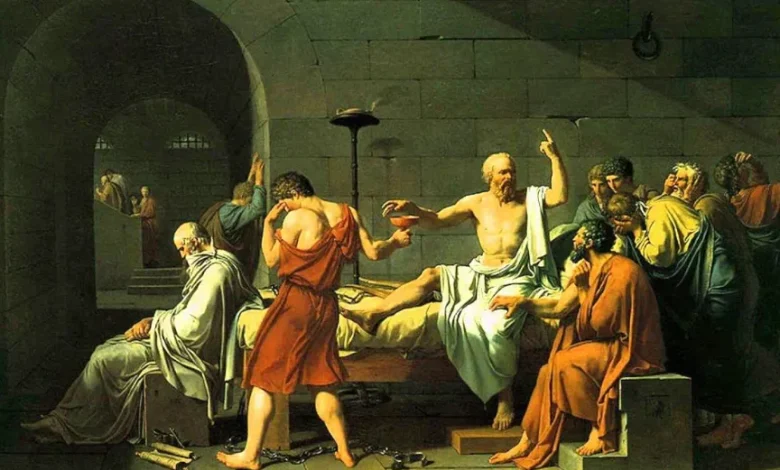Philosophy in Art: Socrates’ Last Lesson

Jacques-Louis David’s “The Death of Socrates” is more than a mere depiction of the Athenian philosopher’s final moments. It is a rich tapestry of ideas, encapsulating the Enlightenment’s ideals through classical themes. This painting, created in 1787, offers a window into the interplay between philosophy and art, making it a significant study for both art historians and philosophers.
Contents
Philosophical Themes and Symbolism
The central theme of “The Death of Socrates” revolves around the virtue of stoicism and the pursuit of truth, emblematic of Socratic philosophy. David captures this through the calm demeanor of Socrates as he reaches for the hemlock, ready to embrace death rather than compromise his principles.
- Virtue Over Life: Socrates’ poised expression and his upward pointing finger symbolize his belief in the eternal nature of the soul and the pursuit of ethical living over mere survival.
- Contrast of Emotions: Surrounding Socrates are his distressed disciples, displaying a range of emotions from despair to admiration, which highlights the human struggle between emotional response and reasoned discipline.
- Light as a Symbol of Enlightenment: The use of light focused on Socrates amidst a darker surrounding underscores his role as a beacon of reason and moral clarity.
Impact on Enlightenment Thinkers
“The Death of Socrates” served as more than artistic expression; it was a political statement and a philosophical manifesto that resonated with Enlightenment thinkers. Philosophers like Voltaire and Rousseau saw in Socrates the ideal of the enlightened individual who prioritizes moral law over the laws of men. David’s portrayal became a symbol of intellectual rebellion and moral courage, ideals central to the Enlightenment.
List of Enlightenment Values Reflected in the Painting:
- Rationalism – Emphasized through Socrates’ logical acceptance of death.
- Individualism – Highlighted by Socrates’ personal integrity and ethical stance.
- Critique of Authority – Illustrated by the context of Socrates’ condemnation by the state.
Reproductions and Their Significance
Reproductions of “The Death of Socrates” have played a crucial role in democratizing art and extending its philosophical dialogues to a broader audience. Each reproduction, whether it be a print or a digital copy, carries with it the seeds of philosophical inquiry and artistic appreciation. They serve not only as educational tools but also as inspirations for contemporary discussions on ethics and morality.
For those interested in exploring this masterpiece in their own space, it is possible to purchase “The Death of Socrates” artwork, available as high-quality reproductions that continue to inspire and provoke thought.
Conclusion: A Legacy Beyond the Canvas
Jacques-Louis David’s “The Death of Socrates” transcends its historical period, offering insights into the enduring nature of philosophical inquiry and the timeless struggle for truth and integrity. It stands as a monument not only to Socratic philosophy but also to the power of art as a medium for profound societal reflection and change.
Through its complex interplay of themes, symbolism, and historical context, “The Death of Socrates” remains a pivotal piece for those seeking to understand the nexus of art and philosophy in the modern world.



